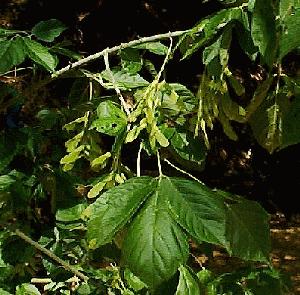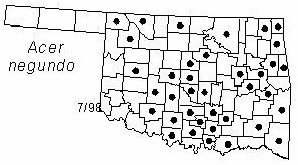
Tree to 20 m (65 ft) tall and 50 cm (18 in) diameter, with broad rounded crown. Bark light gray-brown with many shallow fissures, becoming deeply furrowed on older trunks and branches. Twigs slender, shiny green, usually glabrous but sometimes hairy. Leaves opposite, 13-20 cm (5-8 in) long, pinnately compound with usually 3 but sometimes 5 or more leaflets. Leaflets 5-10 cm (2-4 in) long and 3-6 cm (1.2-2.4 in) wide, long-pointed, coarsely serrate and often shallowly lobed, light green, turning usually pale yellow in fall. Flowers several in clusters on long stalks in early spring, yellow-green, about 5 mm (0.2 in) long, calyx with 5 sepals. Fruits paired samaras 2.5-4 cm (1-1.6 in) long clustered on long stalks.
Distribution: The species is represented by several subspecies and is native to much of the United States.
Habitat: usually bottomland forests, but has been planted in uplands and persists at old homesites.
Comment: Box elder is not commercially important, but is sometimes planted as a shade tree. It is said to yield an inferior sort of maple syrup called "mountain molasses". The seeds are eaten by birds and squirrels. Acer is the old Latin name for maple; negundo is obscure in origin.
NWI status: FACW-
Distribution in Oklahoma: 
The scattered locations in northwestern Oklahoma are probably escapes from cultivation.
BACK
NEXT
RETURN TO INDEX
Last update: 9/7/99
 Go to Oklahoma Biological Survey Home Page
Go to Oklahoma Biological Survey Home Page
 Disclaimer
Disclaimer